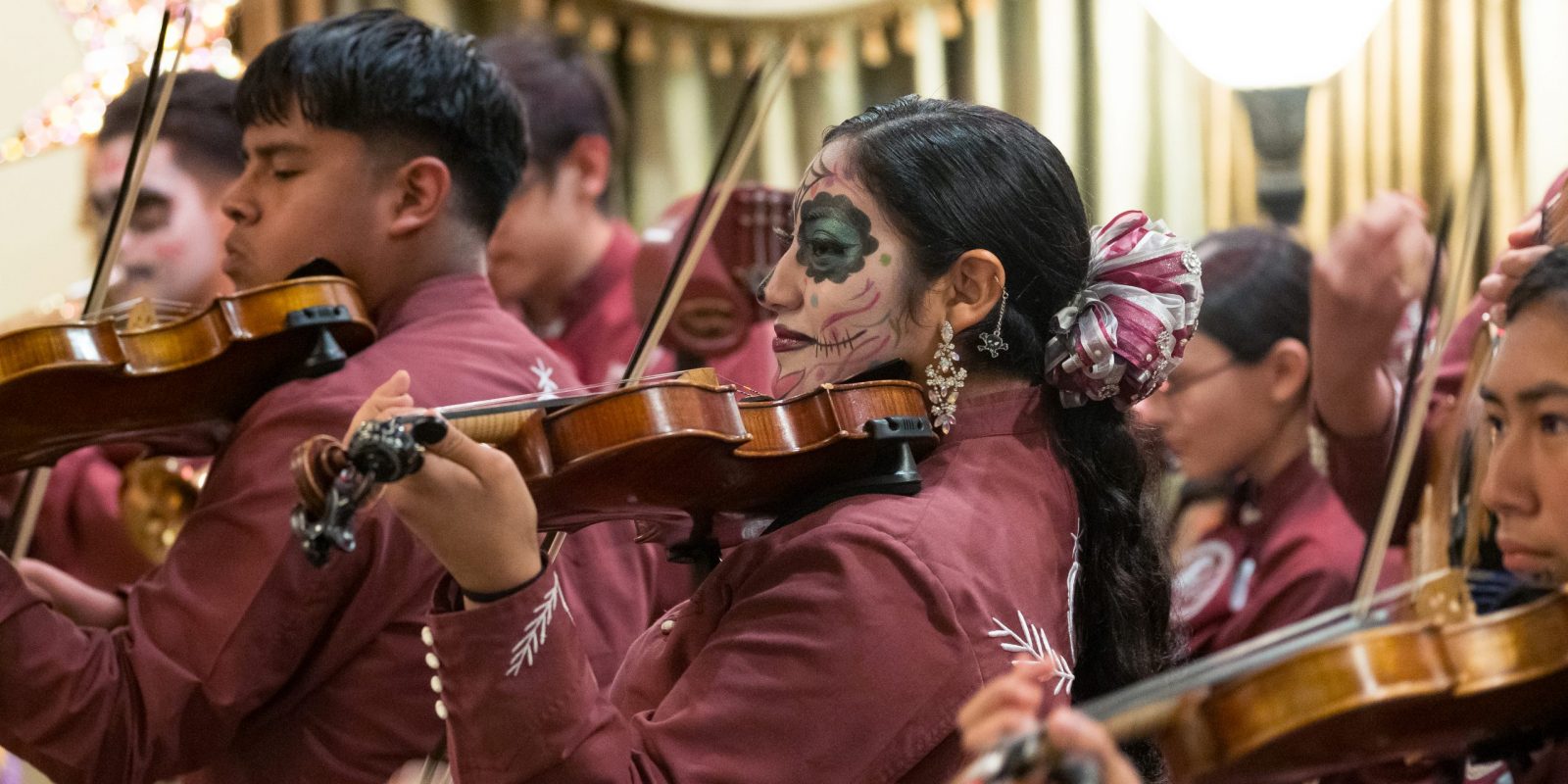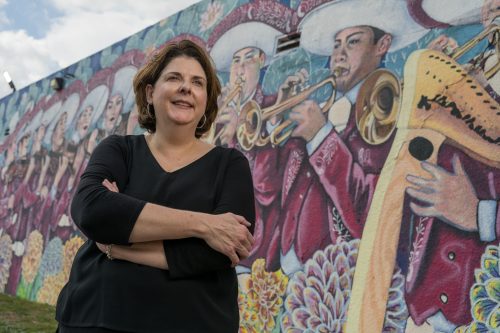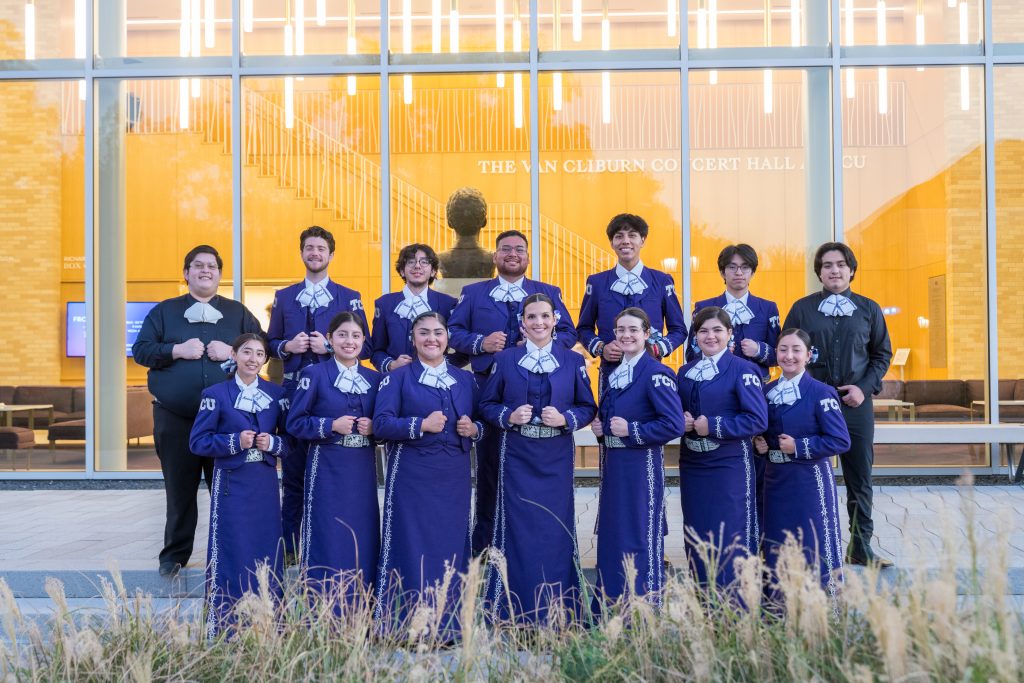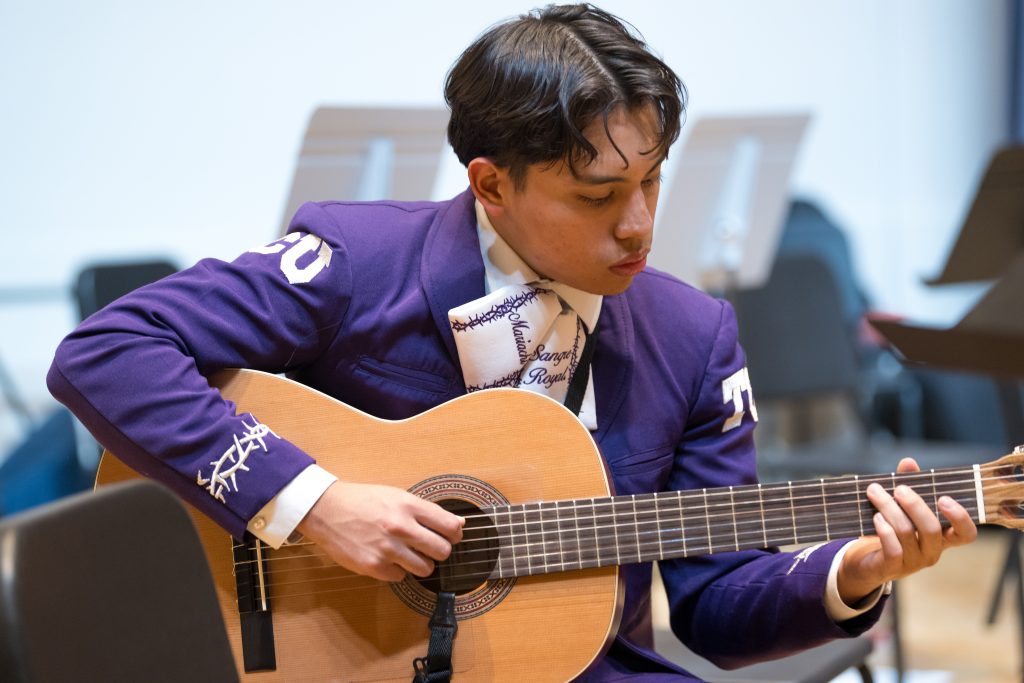
North Side High School’s award-winning Mariachi Espuelas de Plata performs at a Day of the Dead event in Fort Worth. Laura Singletary’s ongoing research led to the creation of a mariachi program at TCU.
The Music of Mexico
Laura Singletary’s deep dive into a high school’s mariachi program spurred the start of one at TCU.
NEARLY 30 STUDENTS IN NORTH SIDE HIGH SCHOOL’S MARIACHI PROGRAM donned their maroon and white costumes to take the stage at TCU’s Van Cliburn Concert Hall in December 2022. The emotional sets of songs they performed ranged from up-tempo crowd-pleasers to mournful tunes that conveyed heartbreak in evocative melody and verse.
Laura Singletary, associate professor and program coordinator for instrumental music education, was in the audience cheering that night. A 20-year veteran of teaching band and orchestra in middle and high schools, she now serves as the TCU division chair of music education.
Singletary knew the performers from her ongoing research at Fort Worth’s North Side High School, where the mariachi program teaches students performance skills along with history and culture. The opportunity to perform as individuals within the larger context of a group creates outsized student engagement, Singletary discovered. Bringing a mariachi program to TCU was a natural outcome of her work.
“Immersing myself in the North Side High School mariachi program is always the best part of my week,” said Singletary, a flutist by training who began her research with the school’s Mariachi Espuelas de Plata group in January 2020. That semester, she spent about four hours a week observing classes and interacting with students. The pandemic disrupted her project, but she resumed her research in fall 2021 and has returned every semester since.
“I am there as a learner, finding out how much time was spent in rehearsal versus playing,” she said. “How much time did the teacher spend giving instructions verbally versus demonstrating on instruments?”

Laura Singletary, standing in front of the mural “Convivio” by Arnoldo Hurtado in Fort Worth, has been researching North Side’s mariachi group since January 2020.
Singletary discovered that the mariachi instructors consistently modeled performing, playing and singing alongside student musicians. She contrasts that approach to her band and orchestra classes, including those she taught before earning a PhD in music education at Florida State University in 2016.
“When it comes to mariachi, there is a stylistic element that you can’t really capture on paper that has to be learned in sort of an apprenticeship style,” Singletary said, adding that some compare mariachi teaching and learning to jazz, where notation is only an approximation.
The performance of the music must be transmitted aurally to some degree, she said.
“There is this tremendous list of musical things like phrasing and breathing and tone quality and articulation and all the things you would talk about in a traditional band or orchestra class,” she said. “But the mariachi directors are right there showing the students what to do. “Modeling is more of a teaching tool here than anywhere I have seen.”
SOUND AND SYMBOLISM
As traditional folk music originating in the southwest Mexican state of Jalisco, mariachi has helped define the country and culture for a century and a half. The term mariachi refers to the ensemble and individual performer as well as to the resonant music itself.
The United Nations Educational, Scientific and Cultural Organization — known as UNESCO — recognized mariachi’s significance in 2011 by including it on the representative list of the Intangible Cultural Heritage of Humanity.
Performers typically wear a uniform called a traje de charro that consists of a jacket (chaqueta), sombrero, neck bow (moño), pants and a pair of boots.
Instruments include a large six-string bass guitar known as a guitarrón and the smaller, higher-pitched vihuela, which has five strings. A harp, a violin and trumpets also help create the distinctive bright sound.
A full-size mariachi group consists of at least a dozen performers. The music style ranges from polkas, waltzes and marches to serenades and mournful ballads, often about love, death, heroes and betrayal. Emotion reverberates in every note.
“The guitar instruments create the rhythm,” Singletary said. “Sometimes you would almost swear you hear percussion in there.”

Mariachi Sangre Royal began as a student organization at TCU before becoming an accredited course in spring 2023. The ensemble’s name, which translates to royal blood, is a nod to the red eyes of TCU’s unofficial mascot, Hypnotoad.
PASSION PROJECT
When it comes to playing instruments and singing, mariachi students must practice to master intonation, chords, melody construction, tablature notation, improvisation and performance.
“We teach all levels of students, from those who have gone through orchestra or band to students who have never before been in a music class,” said Wendy Martinez, associate director of North Side’s Mariachi Espuelas de Plata and an adjunct professor of music at TCU.
Martinez believes the hands-on nature of teaching mariachi enhances student learning.
“When do you ever see a band director come off their podium and just sit with the students as they play?” she said. “Someone could walk into the class and think that the kids are on their own because we are sitting with them in our half circle.”
The “we” includes her husband, Ramon Niño, director of mariachi at North Side High School for the last two decades. He is also an adjunct professor of music at TCU.
Niño welcomed Singletary’s interest in his award-winning program. She’d worried that some might raise eyebrows at her growing excitement about mariachi, given that she’s a white scholar. But Niño and Martinez embraced her, something Singletary believes helped the participants at the school, which is 93 percent Hispanic, become comfortable with her presence.
Niño also appreciates her ongoing commitment to his discipline.
“Most of the time when you deal with a researcher, once they are done with their research, they are uninterested in continuing to pursue it,” he said. “But with her, she is always seeking to learn more.”

Cris Gamez, a member of TCU’s Mariachi Sangre Royal, warms up before a performance with the TCU Wind Ensemble at Van Cliburn Concert Hall. Students in the group rehearse and learn together for three hours each week.
MARIACHI AT TCU
One of Singletary’s TCU students, Emanuel Arellano, encouraged her to form a mariachi group on campus; it began as a student organization before becoming an accredited course in spring 2023. Arellano, a first-generation college student who graduated in December with a degree in music education, knew the group could help students celebrate their heritage through song.
“Mariachi was the missing link for me and a way to connect deeper to my roots,” said Arellano, whose parents are from Mexico. “The Mexican population in Fort Worth and at TCU is pretty large, and I felt like mariachi needed to be part of campus life.”
Singletary recruited Niño and Martinez to help oversee the university’s mariachi program. The group’s name, Mariachi Sangre Royal, translates to royal blood, a nod to the red eyes of Hypnotoad, an unofficial version of the school mascot.
“The goal is for students to be able to teach mariachi once they graduate,” Singletary said. Arellano, a trumpeter who began performing professionally at age 14, did his student teaching with Niño and Martinez at North Side High School.
Tarrant County College students may also take the TCU mariachi class through the community college’s extended education program; students do not need an extensive background in music to participate.
Singletary said the class started meeting once a week for 90 minutes. Not long into the semester, the students said they needed more time together, so Martinez and Niño added a second 90-minute session each week, doubling the time that Mariachi Sangre Royal learns and practices together.
The curriculum is fast-paced, and the group performs often at venues like the Majestic Theatre in Dallas and around TCU.
While her research at North Side continues, Singletary is working to revise the music education curriculum at TCU. She, Martinez and Niño are also developing a music education course called Mariachi Methods, which they hope to launch in fall 2024.
“In the 21st century, there are a lot of ways to be a music educator,” Singletary said. “We need to offer the students more autonomy in how they choose to develop themselves and pursue that unique thing they really care about.”

Your comments are welcome
2 Comments
The Music of Mexico, brought a tear to my eye. As a ‘79 graduate of TCU I was and still am proud to be a Horned Frog.. There was not many Mexican Americans at TCU back then, but friends always wanted to know about our culture. I am happy to see how far we have come. Good luck to Mariachi Sangre Royal. Viva las Ranas Cornudas!
That is great ah me Razaits is great to hear the music of our fathers and mothersa lot of mexican dont even know how to speak spanish this is one way to learn dont no one stop you keep up the good work they will thank you in the end may god bless you
Related reading:
Research + Discovery
Rattling the Supply Chain
Tyson Browning studies the unintended consequences of punitive economic actions.
Research + Discovery
Banking on Growth
As Fort Worth continues to expand, Robert Sturns helps attract big business.
Research + Discovery
Deeper Compassion
Joe Hoyle’s capstone project examines the impact of empathy training on scuba volunteers.